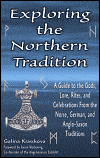
full title: Exploring the Northern Tradition: A Guide to the Gods, Lore, Rites, and Celebrations From the Norse, German, and Anglo-Saxon Traditions
Galina Krasskova was a priestess in the Fellowship of Isis until her conversion to Heathenry in 1996. (She capitalizes all nouns and pronouns pointing to deity and uses a combination of modern and Old English alphabets, which sometimes makes following her prose a challenge.) She was, she tells us, seduced by Woden and is now a Priest of that god. She is also a scholar of her religion who has written a book that describes a muscular, macho religion that holds women in high regard. “Germanic culture,” she writes in her account of Symbel, “the holiest and most significant of Heathen rites,” has “always regarded woman as being innately holy. Women were believed to have a special connection to the numinous….” Because, she continues, there were no Wal-Marts in traditional Germanic lands, “everything was made by hand at home, usually under the auspices of the lady of the house.” This includes spinning and weaving. “The ancient Heathens early on recognized a symbolic parallel between the mortal arts of spinning and weaving and the actions of the Nornir who spun and wove layers of fate” (pp. 162-63). Early in the book, Krasskova differentiates the two major ways modern Heathens practice their religion: (1) learning the lore by reading the sagas and other primary and secondary sources and (2) via Unverified Personal Gnosis, or spiritual epiphany. Presumably it was via UPG that she was seduced by the god. Modern Heathenry arose in 19th-century German Romanticism at the same time as the European Occult Revival that led to Theosophy and modern Rosicrucianism and contemporaneous with the French Romanticism that forms part of the basis of modern paganism. Heathenry got bad press in the 20th century, because people kept seeing a Nazi connection, whereas in fact the Nazi persecuted Odinists along with their other victims. Although Krasskova says that Heathenry is not racist, other books do exist that give the impression of Aryan supremacy. Modern Heathenry has three primary denominations that lie along a “socio-political-religious spectrum” that includes strict reconstructionists (maybe they resemble the Society for Creative Anachronism) and “neo-Heathens” who are “exploring resources that are not lore-based.” What, Krasskova asks, would Heathenry be like today if it had not endured 2,000 years of Christianity? Indeed, what would any “old religion” or paganism be like? Krasskova admits in several places that Neo-Paganism and Heathenry are not necessarily sympatico. Heathenry is indigenous, not manufactured as Wicca is. “While there is nothing at all wrong with being Norse Pagan or Wiccan, to truly be Heathen,” she writes, “one must do more than simply honor the Vanir or the Æsir. One must also adopt and live by some version of Heathen values and worldview” (p. 25). Is she saying that those who follow the Greek, Egyptian, or Celtic pantheons do not live by their values? Chapter 3, which is probably most useful to non-Heathen readers, describes the supernatural beings of the three tribes: the Æsir, the Vanir, and the Jotun (the giants). Beginning with Allfather Odin and Allmother Frigga, Krasskova presents forty-eight gods and goddesses, giving the Norse or Germanic spellings of their names along with the more familiar names. She has written poetic invocations to most of these divine beings and gives meditations for many of them as well. Frigga, she writes, is “maternal without being in the least motherly.” Loki is “the enemy of entropy, of complaisance, and He fights it with a vengeance” (p. 98). Ostara (Eostre) is mentioned only once in the lore (by Bede in De Temporibus Ratione) and nothing is known about her except that she is a goddess of springtime, the “actual moment of the equinox,” Krasskova calls her, “when Winter truly yields its hold on the land…. She is potential in progress” (pp. 112-13). Chapter 4, Wyrd, sets forth Heathen philosophy. “Wyrd orders the multi-verse. Even the Gods must bow to the power of Their own wyrd” (p. 121). Chapter 5 explains the “soul matrix,” or multiple facets of each human being. These include Lík (the physical body), Önd (the “divine breath”), Hamingja (“luck,” which sounds a lot like a mainstream metaphysical definition of karma), and Maegen (“vital force”). Chapter 6 lists the elements of heathen ethics and values—the Nine Noble Virtues, which are courage, discipline, fidelity, honor, hospitality, industriousness, perseverance, self-reliance, and truth. In the back of the book are a glossary (with some pronunciations) and a suggested reading list that includes the primary sources (The Poetic Edda, The Prose Edda, Beowulf) and seventeen modern books. As Krasskova admits, Heathenry may not appeal to most pagans or witches. But consider this: if a gang of bible-toting fundies marched into a Heathen Symbel, they’d crawl back out with their tails between their legs. Reading this book, we get the impression that Heathens are strong folk with whom one does not want to mess around. Mainstream pagans (if there are such creatures) can learn some valuable lessons from Heathens. ~ Reviewed by Barbara Ardinger, Ph.D.by Galina KrasskovaNew Page Books, 2005pp. 220, $14.99
